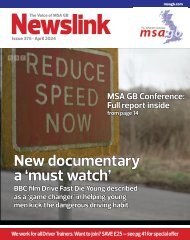Newslink October 2021
Membership magazine of the Motor Schools Association; road safety, driver training and testing news.
Membership magazine of the Motor Schools Association; road safety, driver training and testing news.
You also want an ePaper? Increase the reach of your titles
YUMPU automatically turns print PDFs into web optimized ePapers that Google loves.
Special feature: Vehicle lights<br />
Daytime Running Lights have been a feature of cars for over a decade, but a general poor<br />
understanding of their role has left some drivers in the dark. Tom Harrington explains why their<br />
role in illuminating drivers is critical – and the factors that lead to trouble when wrongly used<br />
DRLs and the importance<br />
of visibility and conspicuity<br />
The golden rules of lighting up your car<br />
are to see and be seen. In accordance<br />
with EC Directive 2008/89/EC,<br />
dedicated Daytime Running Lights (DRL)<br />
were required on all new passenger cars<br />
and small vans from February 2011<br />
onwards, and on all other new types of<br />
road vehicles (including trucks and buses<br />
but excluding motorcycles and<br />
agricultural tractors) from August 2012.<br />
Daytime Running Lights automatically<br />
activate when the engine is switched on.<br />
They are a fantastic asset to road safety<br />
and reduce the likelihood of a side or<br />
head-on collisions during the day.<br />
However, just as the darkness creeps<br />
in unnoticed so too has an over-reliance<br />
on modern technology and the fear is<br />
that too many rely solely on DRLs when<br />
darkness falls during the winter months.<br />
For a time, several US states banned<br />
the use of these lights entirely. In the<br />
1990s, General Motors pushed to<br />
include DRLs on all vehicles in the US.<br />
This was met with resistance, but<br />
eventually government regulations<br />
allowed their use, and their popularity<br />
has increased ever since.<br />
But judging from recent press<br />
announcements, a growing number of<br />
motorists are mistaking their DRLs for<br />
dipped headlights. Now, no one is doing<br />
this intentionally. It’s an honest mistake<br />
as drivers start out in the daytime and<br />
fail to recognise the fading light. But<br />
unfortunately it poses a severe road<br />
safety risk. DRLs don’t produce enough<br />
light to illuminate the road in darkness.<br />
Some manufacturers choose to pair front<br />
daytime running lights with rear ones<br />
too, but it is not compulsory. This means<br />
there may be some motorists driving<br />
around at night in the mistaken belief<br />
that just because they have lights which<br />
switch on automatically at the front; they<br />
are also on at the rear. So, driving with<br />
DRLs at night not only seriously<br />
diminishes your view of the road, your<br />
visibility to others is minimal and you<br />
could run the risk of being rear ended.<br />
Therefore, if you have dedicated DRLs on<br />
your vehicle, make sure to switch to your<br />
headlights during ‘lighting up’ hours –<br />
legally defined as ‘the period<br />
commencing one half-hour after sunset<br />
on any day and expiring one half-hour<br />
before sunrise on the next day’.<br />
Visibility, Detection and DRL<br />
Why is the issue of DRLs so<br />
important? It all comes down to our<br />
ability to see clearly, levels of visibility<br />
and perception.<br />
‘Visual perception’ is a concept which<br />
refers to all perceptual processes and<br />
results imaginable. As a result of its<br />
generalised nature, the literature often<br />
distinguishes between the various<br />
aspects of perception. Concepts such as<br />
detection, conspicuity and visibility are<br />
often mentioned in the perception<br />
literature. For the purposes of<br />
clarification, therefore, some of these<br />
concepts will now briefly be discussed.<br />
The concepts of visibility and<br />
detectability are often interchanged.<br />
Visibility can be defined as a 50%<br />
probability of detection (threshold<br />
of visibility). If an object becomes more<br />
visible it is generally implied that its<br />
detection improves in one way or<br />
another, so that the probability<br />
of detection becomes increasingly<br />
greater; this implies that, in general, an<br />
object can be detected at a greater<br />
distance, or that observers need less<br />
time to decide whether or not an object<br />
is present (reaction time).<br />
Visibility is subject to a human<br />
assessment component, as there is no<br />
equipment that can directly measure<br />
visibility: human intervention is always<br />
necessary to determine this parameter.<br />
Often, such factors are studied with the<br />
22<br />
NEWSLINK n OCTOBER <strong>2021</strong>

















